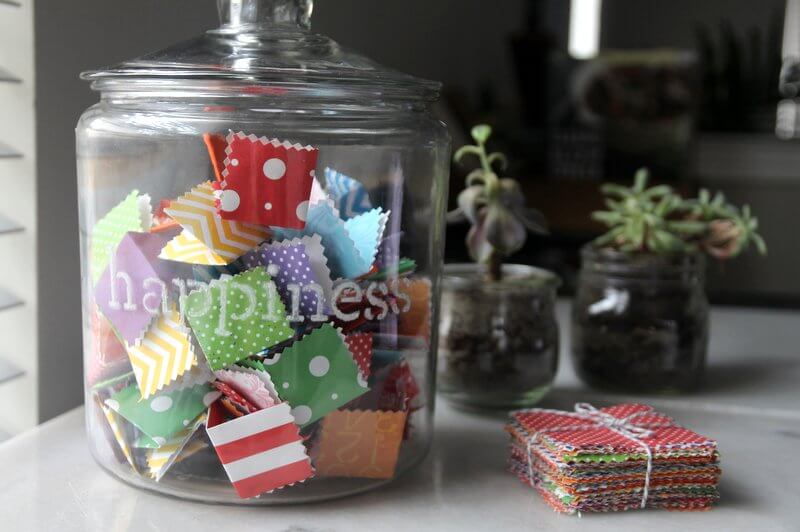
When my husband and I started creating unique and meaningful family traditions, it wasn’t because we’d heard that focusing our lives around experiences rather than things creates more lasting happiness. However the more we’ve incorporated little traditions – like watching home movies on Mother’s Day and making salt dough ornaments together every Christmas – the more true we’ve found it to be true.
According to this study cited in this article from The Atlantic, choosing to focus on experiences, living in anticipation of exciting plans, and “gathering stories and memories” can have a profound impact on how much we enjoy life. It’s part of the secret sauce, it seems, along with a few other essential ingredients.
Why Family Traditions Matter (A lot) ^
One of my favorite parenting books of all time, How To Raise An Adult, advises parents to do less, not more. I follow that principle with my kids, who are fully capable of helping with laundry, meal prep and household chores. In addition to preparing them for life, it frees up some of my energy to focus on creating and keeping family traditions, which are beneficial in lots of ways:
1. They provide a source of identity ^
Traditions and rituals often tell a story about a family. On the macro level, traditions can teach children where their family came from or give them insights into their cultural or religious history (e.g. eating tamales on Christmas Eve to celebrate your Mexican heritage). On a more micro level, traditions can serve as reminders of events that have shaped your family and your children (e.g. every year your family rents the same lake house, and each time you go it reminds you of all the experiences you’ve had on previous trips).” (1)
Why does this matter? Because according to 6 Things The Happiest Families Have In Common, one of the strongest predictors of a child’s well-being is whether they know their family’s history. In an interview with The Week, Bruce Feiler, who authored the New York Times bestseller The Secrets of Happy Families, said this:
“…researchers at Emory did this study that showed that the kids who know more about their family history had a greater belief that they could control their world and a higher degree of self-confidence. It was the number one predictor of a child’s emotional well-being.”
The article adds:
“But here’s what’s really interesting: recounting your family history is not just telling kids, ‘Our family is awesome.’
Recounting the tough times, the challenges your family faced and overcame, is key.Here’s Bruce:
‘Understanding that people have natural ups and downs allows kids to know that they too will have ups and downs. It gives them the confidence to believe that they can push through them. It gives them role models that show your family’s values in practice.'” (2)
2. They create family cohesiveness ^
“Researchers have consistently found that families that engage in frequent traditions report stronger connection and unity than families that haven’t established rituals together.” (1)
3. They provide comfort and security ^
“Traditions can thus be particularly effective during times of change and grief. Maybe you’ve moved your family to a new state and everything is new and strange for your kids, but at least they know that every Tuesday is still pizza night and every Saturday morning they can still count on going on a bike ride with dad.” (1)
4. They reinforce family values ^
In 6 Things The Happiest Families Have In Common, Bruce Feiler was asked “what he would recommend if he could only give one piece of advice.”
His answer? “Set aside time to talk about what it means to be a part of your family.” From the article:
Sit down with them and say ‘Okay, these are our ten central values. This is the family we want to be. We want to be a family that doesn’t fight all the time.’ or ‘We want to be a family that goes camping or sailing’ or whatever it might be.
When my family did it, it was literally a transforming experience. We ended up printing it and it hangs now in our dining room.”
One of our family values is that “We are a family that plays together.” Because I am a DO IT ALL kind of person that loves to tackle project after project, I’ve found that creating traditions around play forces me to embrace that value even when I’d rather “just wrap up this one more thing” that, in all actuality, is a never ending list. Whatever the core values are for your family, traditions can help weave them into the family in a fun, lasting way.
5. And of course, they leave us with lasting memories ^
Interestingly, even experiences that were frustrating in the moment often become beloved family stories. I love to tease my sister about the time she branded my dad on the bottom with a smoldering stick from our campfire, though I promise you no one was laughing at the time.
And of course there are good memories, too. My all-time favorite traditions is taking my kids photos on the same beach every year to document how much they’ve grown. There’s something priceless about having this photo of my oldest son on his first birthday . . .

This one of my second son on the same day three years later . . .

I have so many of them together as older boys, all taken on the same beach, plus similar photos of my daughter nearly every year since her first birthday. They’re such a powerful reminder of one of my favorite sayings:
The days are long, but the years are short.” – Gretchen Rubin
20+ Family Tradition Ideas ^
If you’d like to add some new family traditions, here are a few to consider:
1. Secret Handshake
“Secret handshakes have been used by groups for millennia to distinguish members and non-members. Make one up for your own family. It can be elaborate and complex or simple but meaningful. An example of the latter comes from a family profiled in The Book of New Family Traditions. This family had the tradition of squeezing each others’ hands three times to signal the three words ‘I love you.’ On the day the daughter got married, the father squeezed her hand three times as he walked her down the aisle. ‘Only she knew that this was happening, a tiny personal ritual lodged invisibly within one of the grandest and most public, and she says it was one of the most moving moments of her life.’” (1)
2. Guess Who?!?
A couple of years ago on my middle child’s birthday, my mom and daughter suggested that we try a new tradition. Everyone wrote down something they love about our guest of honor . . . including our three-year-old, who needed help. We tossed all the paper into a bowl, then the birthday boy read them aloud and tried to guess who had written it. He loved it and so did we!
3. Yes Day
“Darcie Gore wrote in Family Fun magazine that she got tired of saying ‘no’ to her three girls constantly and decided to declare the next Saturday ‘Yes Day.’ She started a ‘Yes Jar,’ so her daughters could deposit written requests for things they couldn’t do immediately, such as ‘wear my Cinderella dress all day.’ On a Yes Day, the activity requests are read, and all the kids pick one special thing they want to do that day. The first Yes Day began with a breakfast of chocolate milk and donuts, and included such activities as freeze tag, a pillow fight, and the application of toenail polish.” (5)
4. Family Time Capsule
Each family member contributes a few of their favorite things, notes, and present-day period items to a waterproof box that is opened 10+ years later. Including voice recordings and/or video is recommended. (If you move before the ten years is up and you buried it in your yard, make sure to take it with you!)
5. Happiness Jar
One of our simple traditions is the Happiness Jar. We go around the table at dinnertime and share the best moment from our day, then write it down and put it in the jar. It helps our whole family to re-center our thoughts on what we are grateful for and allows us to celebrate the joy of others. (Just a quick note: There are days we forget to do this, and I don’t sweat it. This New Year’s Eve I’ll be relishing the moments we captured, not thinking about the ones we didn’t.)
6. Family Meetings
I love this tip from 6 Things The Happiest Families All Have In Common:
You’re not mom or dad anymore — you’re now co-CEO’s. To find the way to keep a family improving, Bruce turned to the world of business.
Your family needs a weekly board meeting with all the shareholders present. Sound cold and clinical? Wrong.
Bruce’s wife says it’s one of the best things they’ve done to make their own family life happier.
It’s not complicated and it only takes 20 minutes, once a week.
Here’s Bruce:
‘We basically ask three questions. What worked well this week, what didn’t work well this week, and what will we agree to work on in the week ahead? And if the kids meet the goal, they get to help pick a reward. And if they don’t, they get to help pick a punishment. They don’t do it without us, but we all do it in consultation.'”
I personally try to focus on the natural consequences of missing a goal rather than punishment, but I like the idea overall.
7. Saturday Mornings In Bed
“Choose a morning on the weekend to spend in bed with your family. You don’t need to spend hours laying around, but 15 to 30 minutes is a nice length of time. Try having coffee, tea, or milk with a couple of cookies. Relaxing and taking a few minutes to connect with your family can be a great way to kick off a weekend.” (3)
8. Have The Same Family Meal One Time Every Week
Friday night pizza, Taco Tuesday, Saturday morning waffles, etc.
9. Make Holiday Ornaments Together Every Year
Almost every year since my oldest was born we’ve spent an afternoon making holiday ornaments. Some we keep for our growing collection, and some we give to grandparents. We’ve made yarn balls, salt-dough ornaments, and painted pre-made ornaments.
Other holiday tradition ideas:
- Bake together – sugar cookies or gingerbread cookies are our go-to recipes
- Create a winter book exchange
- Dye Easter eggs together using ingredients from your kitchen
- Throw a costume party on New Year’s Eve
10. New Privilege/New Responsibility Cards
“Amidst all the fun and hoopla, remind your kid that with age comes greater power and with greater power comes greater responsibility. In addition to birthday presents, present your child with two envelopes. One envelope is labeled, ‘New Privilege’; the other, ‘New Responsibility.’ Provide an age appropriate privilege and responsibility each year.” (1)
11. Camping In Your Backyard
A camping trip in Yellowstone isn’t always practical, but no worries! With a few old blankets and tent, you can give your kids an enjoyable outdoor experience. Tell great stories, make flashlight animals, and make it a night your children will remember.
12. First Day of School Photos
I take first day of school photos even though we homeschool. Nothing marks the time quite like a kid holding up their grade sign with a big grin.
13. Monthly Daddy/Mommy Date
I’ll admit, the whole “dating your kids” idea sounded weird to me at first, but it’s seriously the best. Mom and Dad take one child out on a date to the place of their choosing, then the next time another child has his or her turn.
Each child gets to be the center of attention with no competition for a little while, and at least in my experience it helps them open up and share more about what they really think and feel.
14. Monthly or Annual Service Project
Whether it’s helping out at a local farm or putting together meals for families who just welcomed a new little one, a service day creates awareness of needs outside of ourselves and demonstrates what kindness in action looks like.

15. Valentine Hearts
My kids adore this tradition that Kate shared here. Basically, from February 1st to Valentine’s Day you leave heart-shaped notes on kids doors while they’re sleeping. They can be something you love about them, encouragement, or a fun story about them. Whatever it is, they soak it up even when they don’t act like it . . . I know because one morning I forgot and they all reminded me. 🙂
16. Board Game or Movie Night
Take turns letting a different family member choose the movie or game each week. This simple tradition reinforces the belief that every member of the family is important.
17. Family Walks
Early in the morning or after dinner, family walks open the door for conversation, gentle exercise, and a routine opportunity to experience the calming effect of being outdoors.
18. Bedtime Stories
“Reading to young children stimulates their development and gives them a head start when they reach school, according to researchers who have reviewed studies on the effects of reading. Apart from helping their reading, sharing a bedtime story with a child promotes their motor skills, through learning to turn the pages, and their memory. It also improves their emotional and social development.” (4)
19. Kids Make Dinner One Night A Week
Depending on their age it may be something as simple as scrambled eggs and an easy side, but they’ll have the joy of making a meaningful contribution to the family and you’ll have the night off!
20. Don’t Say Cheese
But do use one of these techniques to get your kids to smile for a “time-lapse” photo series.
Every Mother’s Day since my two boys were born, we’ve taken a picture of the three of us in front of the same flowering tree. This shows how much the boys are growing. We can also see how far along the spring is coming by seeing if the tree is blooming yet (we’re farmers, so we like to compare). I also take a picture of them at our favorite summer holiday location. It’s in the same museum we visit every year. Another idea I’ve heard of is people taking a picture of their child in the same oversized shirt. This shows them growing into it. Very cute!” – Cindy from Alberta
21. Surprise Hooky Day
“One mother I know surprises her kids by ‘kidnapping’ them from school one day a year. She pays attention to when tests and school field trips are scheduled and picks a day when they won’t miss much. The kids go off to school, their mother takes a shower and dresses, then shows up at school and surprises them. Once they get in the car, the lucky kid gets to decide how to spend the day.” (5)
22. Milestone Trips
When I was growing up, my dad took each child on a special trip for two milestone birthdays – age 10 and 16. The trip was a rite of passage and an opportunity share our excitement (and our fears) about the next stage of childhood.
23. The Birthday Hat
“Get a hat that is well suited to your family and make this the ‘official birthday hat.’ The idea is that each person wears it at their birthday dinner, whether that be at home or out in a restaurant. We have a rather large birthday hat in our family – it looks like a cake complete with big felt candles out of the top. It’s ridiculously awesome.” (3)
24. Q&A a Day
This tradition is based on Q&A a Day for Kids. Basically, the idea is that you ask your kids one fun question every day for a year and write down their responses. Then the next year, you ask them all the same questions and see how their responses change as they grow.
25. Cousin Camp
This is a tradition my family came across by accident. Years ago, my sister and I planned family trips to the same beach on the same week . . . without discussing it . . . two years in a row. We live several states away and our kids loved their time together, so now that I live near that shore we’ve made gathering here an annual tradition.
The week is one big glorious “Cousin Camp” sleepover – complete with homemade waffles and early morning fishing trips – and I’m so grateful for the memories we’ve made so far.
26. Freedom Day
Even when we do our best not to overschedule, sometimes kids can feel overwhelmed. In the The Book of New Family Traditions, one mom describes her solution – the last Saturday of each month was designated as “Freedom Day.” Her son had the option to skip chores and social obligations, do what he wanted to do (within reason), and just have a “me” day.
27. Movie Making Day
Write a one act story as a family, then dress up in silly costumes and record a brief scene. Grab some snacks and watch it together (plus any previous ones you’ve made) for a good laugh.
28. Best & Worst List
This idea also comes from The Book of New Family Traditions. Basically, on New Year’s Day you all answer the 10 questions below. It’s a great way to learn about your kids and vice versa.
- Best thing that happened to you?
- Worst thing that happened to you?
- Best thing you accomplished?
- Best thing you did for another person?
- Best movie you saw? Worst movie?
- Best book you read?
- Best TV program of the past year?
- What current events of the past year will make history?
- What will you remember most about this year?
- Name three things you hope for most in the new year.
Do you have a favorite family tradition? Share it in the comments below!
Sources:
1. McKay, Brett and Kate (2013) Creating a Positive Family Culture: The Importance of Establishing Family Traditions. Retrieved from https://www.artofmanliness.com/articles/creating-a-positive-family-culture-the-importance-of-establishing-family-traditions/
2. Barker, Eric (2014) 6 Things The Happiest Families All Have In Common. Retrieved from https://theweek.com/articles/444395/6-things-happiest-families-all-have-common
3. Oxenreider, Tsh. Small-big family rituals. Retrieved from https://theartofsimple.net/the-importance-of-family-rituals-2/
4. Randerson, James (2008) Benefits of Bedtime Reading. Retrieved from https://www.theguardian.com/education/2008/may/13/schools.uk4
5. Cox, Meg (2012) The Book of New Family Traditions: How to Create Great Rituals for Holidays and Every Day









Actually…I DO read Art of Manliness all the time, even though I’m a woman. Such a good site!
Haha! I can’t say I am a regular reader, but I have loved the few articles I’ve come across. 🙂
I was going to say the same thing she did. AoM is one of my favorite blogs 🙂
I love this! My family has a million and ones traditions when it comes to holidays, but I’ve never really thought about traditions for the everyday. As a military family I could see how these would great to maintain some consistency when everything else is changing almost constantly.
Oh I just LOVE this! As our son has gotten older, I think about this even more often… how we can create special memories that bond us together. One thing I’ve always wanted to do, but just never have done it, is to celebrate “Christmas in July”… where we decorate the house with those (usually tacky) Beachy versions of Christmas decor and listen to Christmas music. Haha… I only allow myself Christmas music twice a year… AFTER Thanksgiving (through New Year) and in July… so it just seems fitting 🙂
These are great! I have two under 2, but I’ve printed these out, so I’ll remember as they grow older. Love your bog – always find it rejuvenating for me as a mom. Thanks for taking the time to share your ideas!
Every time my family gets together (holidays, birthdays, even family dinner), I bring my camera and tripod to take a family picture. We take 2 pictures- one serious, one goofy. I occasionally hear a grumble about having to take “another picture”, but everyone loves looking at them, especially the goofy ones! There’s going to be a day where people in those pictures will no longer be with us, so it’s nice to have the memories!
I completely agree on tradition…never knew why but just LOVED them. We have a few but the ones I am adamant about are State Fair picture with Big Tex and new Christmas pajamas for the kiddos to wear on Christmas Day! Side note: oh my potami are your kids GROWING up so fast! I have forever locked your oldest girl with the smiles and garden hose pose via the cavity post, your little in the middle beach pic and the littlest via your birth story post. I.CAN’T.EVEN….
This month I’ve been thinking about family traditions, so this is a timely post! Thank you for the ideas!
My children are all grown and although we did have some family traditions, this list makes me long for a chance to do it again and implement some of them (though I must admit that there are aspects of child raising I *really* don’t miss). We always made a point of having supper together, and were amazed at the number of people in our church and community who never had a daily family meal because everyone ‘was too busy’.
Your website is awesome! You have good things for families, thank you.
I love family traditions! I think it’s one of my favorite things about having a family. I really like the “happiness jar” idea, although the evenings are a little crazy around my house, and I’m not sure we would get around to it!
A lot of our traditions are about celebrating the of holidays together – Michaelmas (or Mabon), Halloween, Day of the Dead, Thanksgiving, Yule, Christmas, Imbolc (Candlemas), Easter (Ostara), May Day, the summer solstice…. there’s always so much to celebrate, and lots of fun things to do around holidays.
Another fun family tradition is the one big birthday party we do in the fall for all three children. They are all fall babies, so it works out great. It’s usually our one big party for the year – no presents or cake (we do that on their actual birthday as a quiet family thing), and some kind of theme – one year was medieval with a blow-gun capture the flag game (using pieces of PVC pipe and acorns), there was a pirate year with a treasure hunt, last year was tea-party-and-cricket-match. It’s a great excuse to get a lot of kids together and have fun.
This is a great list! Will be sharing 🙂
We’ve had a ritual that if the moonrise is close to dinner time we go for a hike to the hills and eat dinner outside watching the moon rise with our daughter. Then walk back in the dark with flashlights. She loves it =) She’ll be 3 this March. =)
Excellent ideas! I will be implementing one or more into my routine while babysitting my grandchild—- thanks so much for publishing a thought provoking article!
For my family we had many traditions that I now cherish as we just started our own little family and have a 7 month old baby girl 🙂 My favorite, however, was the “13th Birthday Trip.” We SO looked forward to our 13th birthday where we would be able to choose one destination that we always wanted to visit and take one parent with us! Since we lived in Portland at the time, the location had to be on the west coast and lasted about 5 days if I remember right. My older sister chose my mother and they went to Vancouver BC and visited the Bouchart Gardens! I took my dad to San Diego to visit the famed San Diego Zoo and be in “tropical weather.” My little brother chose Disneyland and my mom and I went down and surprised them! It was the BEST!
My husband and I live on Oahu, so our kids will get to pick an outer island or mayyyybe west coast hehe!
When I was growing up my hippie mom and I had a song. “Oh we aint got a barrel of money, Maybe we’re ragged and funny, but well travel along, singing our song, side-by-side.” Dad had been killed, and we were broke, but happy. Even now, I can hear that song. It empowered me. I felt like we could do anything. Get through anything. And we did. I have three kids and they each have a “song” with me.
This is awesome, how lucky you are to have had a hippie mom! I make up songs (especially while driving with grandkids). They love it!
A new family tradition of ours (starting this summer) will be our ‘annual water balloon fight’. I bought hundreds of water balloons from ebay for dirt cheap (using water balloon makers-the ones that fill 100 in less than 60seconds). We’re in for a lot of fun ! 😀
We used to enjoy innumerable number of Phuchkas (street site crispy round semolina balls with potatoes stuffed inside) at our home after the immersion ceremony of Devi Saraswati, the hindu goddess of knowledge, wisdom, music and learning. The Phuchka vendor used to receive special invitation for that particular day. It was a tradition we all followed generation after generation.
Love the ideas. One tradition we do is to give the kids “dreams” each night. When we give our good night kisses they ask for a dream. We try to come up with the cutest, fun imaginary things to think about. EX: if every one of your fingers had a magic power, what would they all be? or Think of a tiny mouse family in the walls, what do they wear, eat, talk about. or if we lived in a mushroom land, how would we build a house?
The kids love to tell us the stories they thought out each morning.
We had many traditions while my daughter was growing up.
She was born Thanksgiving week, so we always have birthday cake at Thanksgiving.
Our family always have our get togethers the Saturday after the holiday. Then we don’t have to stress about spouse problems. We can relax and have a good time.
The Tree would go up the Sunday after Thanksgiving, and we ate leftovers for dinner.
We would always make Christmas cookies.
When she got older, in September, she would have a couple of friends over for the weekend. We would process pumpkin, make pumpkin bread, pumpkin seeds, and pumpkin pancakes. After the first time, this was their idea to keep doing it.
And that is just a few of them. Now she is married and we don’t get to do many of the things we used to. But we have great memories.
My family has a couple. First I make my girls birthday cakes every year. They get to choose the theme and together we plan them and make them. They usually start their order months in advance. Christmas cookies every year. Family ornaments.Fun Fridays which include either a craft, activity,or movie and pizza. And at bed time we go over the favorite part of our day, and something we are thankful for. I loved the jar idea of holding all of them and going back over them at the end of the year. Definitely going to use that.
Wauw, such awesome ideas! My heart always seems to pound a bit faster when I read about such practical ideas to improve family-live! Question: “the -q&a a day idea- sounds great, but you mention a book (link doesn’t work). Could you tell me which book you revere too?
A tradition of ours: we have a pot filled with stones. On white flat stones are dates of special memories and on the other side a word which markes the memorie. The idea is when our kids are a little older to create time after family dinner (for example on friday-evening), that one of the kids may take out a stone and myhisband and I will tell about the special story/memory mentioned on the stone.
Hey Roelofke! Thanks for letting me know that link was broken. I just updated it.
I love the stone idea!
This is a great list! Another idea to add is a “Celebration Plate” a good-safe plate that either the kids decorated or an over-the-top crazy thrift shop find perhaps. Whenever someone has an accomplishment that they’re really proud of, they eat from the celebration plate during dinner. And, of course, there has to be a celebration log book to record all of those events.
Meant to say “food safe” not “good safe” ?
When my daughter was very little, her Dad traveled frequently and she missed him. I got a memory box for her to keep under her bed. She put things she found or discovered in this box, like feathers, rocks, leaves, even bugs! When her Dad got home, he would go to her room after dinner and sit on the floor with her. She took out each object and told him about it, how she found it, what she liked about it. It was so good for her—- she kept some of these treasures for her whole childhood.
I’m a grandmother and I bought a 6′ tall cardboard candy cane which I hung in our guest bedroom high on the inside of the door. Each year, when the grandkids were here for Christmas, we measured them on it and marked their names and the date. In later years, we measured them whenever they visited. The 2 boys, 3 years apart have grown at the same rate and look forward to the comparisons.
Just came across your site and I LOVE it all! Love these ideas! I wish I had been following you for the past few years! Thanks so much!
We have many traditions, but one of my favorites is salt dough nativity scenes at Christmas time. A big batch of salt dough is made, and everyone draws a piece of paper out of a bowl or hat or whatever. Those pieces of paper have a specific part of the nativity scene to make out of salt dough. When we are finished, we bake the dough or let it set out until it gets hard. We have made many memories while doing this every year. It’s fun to see how everyone’s part comes out. We even do this with little kids. Sometimes we get Christmas porcupines instead of sheep, but that’s what makes it fun!
The most memorable traditions were PJs on Christmas Eve and a new ornament picked out each year around the time we put up the tree. My dad’s side of the family has parties the Saturday before Christmas and on the 4th of July. A co-worker of mine takes her daughter’s birthday week of and they put activities in a hat and do one each day (ie zoo, movie, children’s museum). I just had first a few months ago and can’t wait to start my own traditions.
I really loved this post! As the holidays are quickly approaching, giving more thought to the family traditions we want to share in our family. With a 1yo and 3yo sometimes it’s hard to keep traditions in mind, but love the really simple ones like a secret handshake. And will definitely try the happiness jar soon with our 3yo! For the holidays, we’ve already made funny Santa pictures a tradition — i.e., our kids crying with Santa. I will do this until the kids our of our out of the house! I print and frame them bring them out for every Christmas at home. I know my kids will get a kick out of looking at them especially as they enter their teen years.
I love all your suggestions. We do a bunch of those already but a bunch were new to me as well. My favorite was the birthday person getting to read what people wrote about them and guess who wrote it. Sounds like a fun family tradition for us to try! Thanks for the idea.
You mentioned family cohesiveness improves with certain traditions, old and new. I agree!
I can’t tell you how important this is.
I have three brothers. The eldest passed away at 47. We were sent to different boarding schools and essentially separated when we were all mid teens.
We never really got it back together. I suffered chronic, debilitating homesickness. Not just for home but for my family unit. However much I tried to explain this to my parents, I was seen as disobedient and not doing as I was told. This really had a terrible effect on me.
Times have changed for the better and new generations take notice of their children and listen to what affects them and to what children have to say. This is a wonderful thing!
It’s been a lot of years since I have had contact with two remaining brothers, but I still miss them like I did on the first day alone at boarding school.
Lovely post Heather!
I’ve found the comments to also be very interesting and your comment makes my heart ache with empathy!
While there are so many negative changes in the world, you’re so right: this is a wonderful change!!!
Our weekly family council is a great place for everyone to bring up points to discuss and plan the upcoming week. ❤️
I think it would be wonderful to just print out your comment and send it to your brothers. Time is getting away from us, and we’ve found reconnecting now, during the CoVid pandemic, has brought a lot of silver linings out of this dark time.
Thank you so much for these wonderful ideas. With the pandemic we haven’t been able to spend time with our grandchildren. We have begun regular Facetime meetings with them playing games and doing all kinds of “distance” activities. It’s been a life saver for my husband and me. I will certainly use some of these ideas during those precious moments with my grandkids. You also have reminded me of a tradition we had with our children that has fallen by the wayside. I think we will revive it with the grandchildren now. Thanks again.
One of our family traditions is everyone in the family gets new pjs for Christmas to open Christmas Eve and wear on Christmas morning. May kids are grown but they still do the tradition with their family.
Friday night Pizza and dessert night has become sacrosanct at our house!!